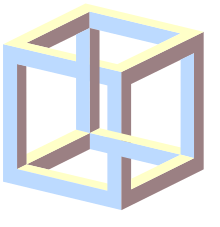
Back شكل مستحيل Arabic Невъзможна фигура Bulgarian Objecte impossible Catalan Unmögliche Figur German Ugèt impusìbil EML Neebla figuro Esperanto Objeto imposible Spanish شیء غیرممکن Persian Mahdoton kuvio Finnish Objet impossible French

An impossible object (also known as an impossible figure or an undecidable figure) is a type of optical illusion that consists of a two-dimensional figure which is instantly and naturally understood as representing a projection of a three-dimensional object but cannot exist as a solid object. Impossible objects are of interest to psychologists, mathematicians and artists without falling entirely into any one discipline.
- ^ Bruno Ernst (Hans de Rijk) (2003). "Selection is Distortion". In Schattschneider, D.; Emmer, M. (eds.). M. C. Escher's Legacy: A Centennial Celebration. Springer. pp. 5–16. ISBN 978-3-540-28849-7.
- ^ Barrow, John D (1999). Impossibility: The Limits of Science and the Science of Limits. Oxford University Press. p. 14. ISBN 9780195130829.
© MMXXIII Rich X Search. We shall prevail. All rights reserved. Rich X Search